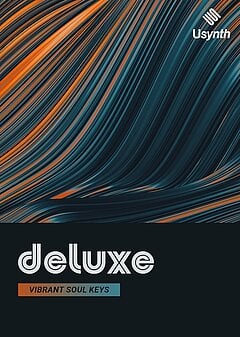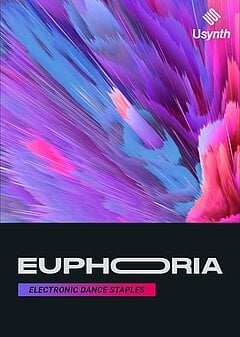How to Produce Laid-Back R&B
A simple, step-by-step guide to creating relaxed R&B songs, from blank DAW session to complete arrangement.
APRIL 8TH, 2022
Kick back and read carefully until the end of this tutorial to find out how to create relaxed RnB grooves, add ambient synth chords with Usynth DELUXE and lay down a bass line from scratch:
Creating a relaxed groove
If you want to catch up on the essentials of hip-hop beats, check out our article, The Ultimate Guide to R&B. This will help you create more of a foundation before you continue on!
If you’re unfamiliar with double and half time, double essentially means that the beat moves twice as fast as it feels like it should, while half time implies the beat is moving twice as slowly. This is a simplified explanation, but functionally it should give you a good idea of what’s involved. Why mention this? Because it will allow you to instantly dial up the chill factor of anything you write, and R&B is no exception.
Start by sequencing a medium-tempo drum groove and place the hi hat and aux percussion rhythms exactly how you like. Now, stretch out the kick and snare groove to be twice as slow — if this pushes the kick and snare to beats that sound “wrong”, tweak the timing slightly until it works. Listen to the result without moving the rest of the percussion, then again after you’ve stretched its timing out in the same manner. See if either of these options creates a more relaxed feel, and note how it feels to have so much extra space between the kick and snare. If you haven’t added any other instruments yet, your song will feel quite bare; don’t worry, though, that will change quickly.
From here, you can start adding more percussion back in and making things slightly busier ... but now, you’ll be “primed” to create a more laid-back song. Get the beat to a point you’re happy with, then it’s time to add chords.
Ambient chords
One of the simplest and most effective ways to create laid-back R&B chords is with keyboard instruments, most commonly electric piano. This is often a better arranging decision than focusing in on a synth to push things forward, as you have the natural touch of an acoustic instrument with imperfect note timings, volumes and releases. UJAM’s Usynth Deluxe is a great VST for this, as you get the best of both worlds — it’s also much easier to mix than bringing in a standard electric piano plus multiple different synth layers to fill out the space. Try the Funky Pulse Wah preset, turn off the Finisher and start tweaking to find your sound.
Nail down a simple chord progression you like with that preset and add in some filler notes here and there between the chords. This will keep the song from sounding too simplistic or raw, but you’ll still want to keep things simple at this stage. Try adding clean chords over top of the keys with Virtual Guitarist SPARKLE — if you keep things light, this will add just the right amount of thickness and gloss to your chords. Throw on a reverb you like and some delay and let this lean combo add warmth and shine to your mix!
To thicken up the low mid range, it’s not a bad idea to add in some synth pads at a low volume; Usynth Euphoria is a great choice for this, especially if you turn down the Dark/Bright knob and add some smooth reverb via the Finisher section. With all of these elements in your chords, your arrangement will come together in no time! Aside from vocals, which are out of the scope of this article to cover, there’s just one more key element to add.
Bass
If you want to get to a rough mix quickly, you may want to plug in the root note of each chord and fill out the low end. For the final production, however, it’s essential to add much more variety than this. The EDM approach of a static sub doesn’t play well in such a dynamic environment; R&B requires a more nimble touch, even when you’re aiming for a gentle, relaxed feel. The question then becomes what to write.
By using a bass like Virtual Bassist DANDY, the legwork is largely taken care of for you. This VST allows you to choose from different style phrases and freely edit the midi, which ensures that you never have to start from a blank slate; it’s easier to tweak a template bass line than create an entirely new one! This way, you can stay deep in the writing process and shape the vibe of the song while some of the fine details are taken care of for you.
Should you still want to create an R&B bass line from scratch, there are a few things you can do outside of simply playing chord roots. A great example is doubling the melody here and there (not constantly, of course); this helps the bass lock in with the rest of your virtual ensemble. Another option is to outline chords, especially at the fifth and the octave — essentially, creating movement with only low-hanging fruit. Combine this with a few walking bass notes and you have the building blocks of a great R&B bass part!
Wrapping up
If you follow the approach outlined above, you shouldn’t have a terribly difficult job at the mixing stage. Simple arrangements often translate to simpler mixes, where your decisions are largely stylistic rather than technical (things already sound pretty good, so your task is more about bringing out what you like instead of cutting out stuff you don’t. One of the most important things you can do is to never over-compress your mix. A laid-back feel comes from giving everything room to breathe; not just the beat, but also the dynamics and frequency balance. Above all else, preserve the natural character of what you create.
Those are the essentials — it doesn’t need to take much more than that to produce a chill R&B track you love. You can add hundreds of tracks and tens of automation lanes per audio track if you choose, but everything you add should be in service of your core vision for the track. Be ruthless about this and you’ll consistently be far happier with the result. If you ever find yourself needing better tools, the ones linked above are a fantastic place to start!
About the Author
Harry Lodes is a copywriter, marketing consultant and content writer for audio and ecommerce brands. He lives in the Philadelphia area, releasing Eastern/Western hybrid EDM under the artist name KAIRI hearkening back to his roots in Berklee College of Music.
Stay up to date
Sign up and we’ll send you an e-mail with product news and helpful stuff every now and then. You may unsubscribe at any time.
Defy Limits
We develop software solutions that enable people to create, consume and interact with music.




